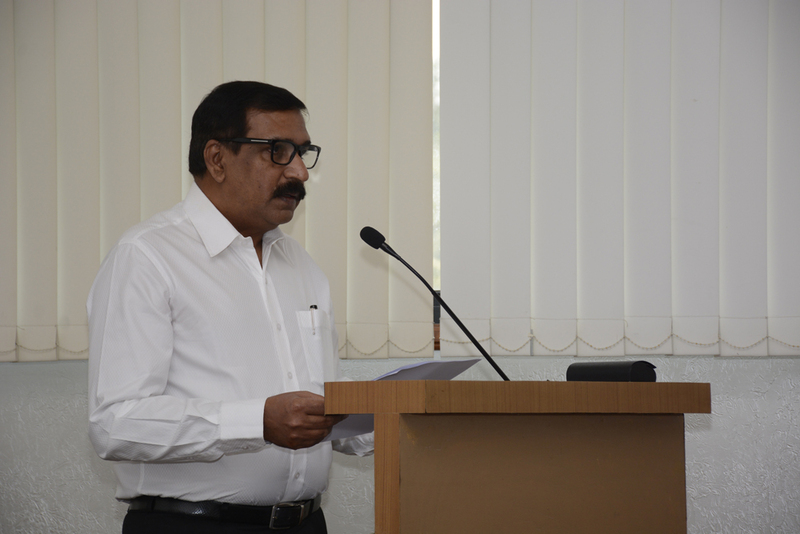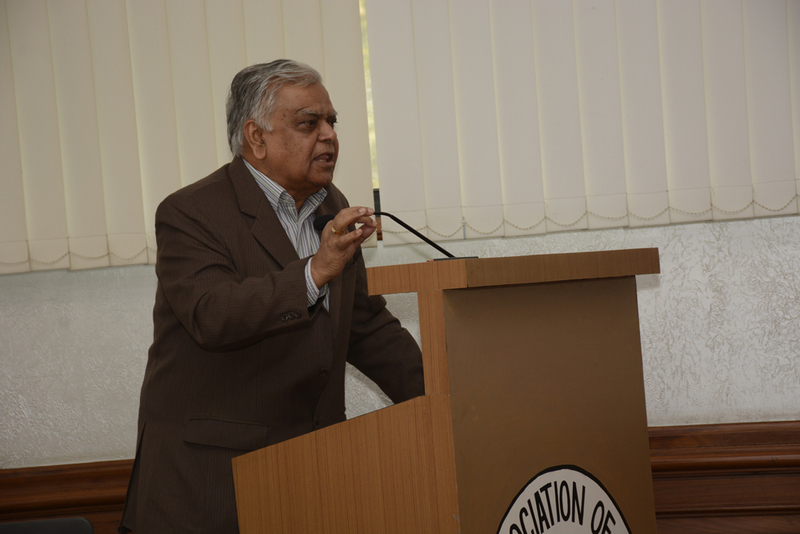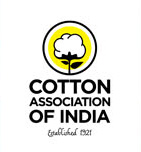Cotton Association of India has organized a talk on the subject of “Management of Pink Bollworm” on Wednesday, the 10th January 2018

Welcome Address by the CAI President Shri Atul S. Ganatra
My Dear Dr. C. D. Mayee, Distinguished Guests, My Dear colleagues on the CAI Board, Members, Ladies and Gentlemen,
It gives me immense pleasure to welcome you all here today at CAI.
As you all are aware, Pink Bollworms (PBW) have created havoc this year and ravaged the cotton crop in Maharashtra and Telangana and caused substaintial damage to farmers.
It has therefore become critical to create awareness and impart knowledge about how to arrest the menace of pink bollworm. It is extremely important for the farmers and all others connected with cotton to know how to break the life cycle of pink bollworms. This becomes crucial as in some parts of the country, the Government agencies themselves are advising to uproot the cotton plants to break the life cycle of pink bollworms.
I am extremely indebted to our cotton friend and expert Dr. C. D. Mayee to have readily agreed to come to this Association and make a presentation on Management of Pink Bollworm. I am sure his presentation today will give all of us a true insight on this topic.
Friends, all of you are familiar with Dr. Mayee and he needs no introduction. However, for the benefit of our new members, I wish to narrate some of his achievements in brief:
Dr. C. D. Mayee is a noted scholar in the field of agriculture particularly cotton having worked on very important positions in the country. He was the Vice-Chancellor of MAU, Parbani, Director of CICR Nagpur, Agriculture Commissioner, Government of India, Chairman of the Agricultural Scientists Recruitment Board (ASRB) of the Indian Council of Agricultural Research ICAR).
Dr. Mayee is also the President of Indian Society for Cotton Improvement, Mumbai since last eight years. He is also heading South Asia Biotechnology Centre, New Delhi. Dr. Mayee is a recognized International Scientist with specialization on cotton.
Dr. Mayee is a fellow of Maharashtra Academy of Sciences and National Academy of Agricultural Sciences. He has a vast experience in the field of cotton and he is extensively travelled across 30 countries of Asia, America, Europe and Africa in pursuits of science discussion of Policy Framework.
Before I request Dr. Mayee to start his presentation, I wish to welcome him with a bouquet of flowers.
`I sincerely hope today’s presentation by Dr. Mayee will impart a lot of insight on this very important topic of Pink Bollworm to all our members and our friends from Media present here today and encourage them to help farmers by creating awareness.
Dr. Mayee, the floor is yours now Sir.

The brief of the lecture points delivered at the COTTON ASSOCATION OF India (CAI), by Dr C.D. Mayee - President Indian Society for Cotton Improvement (ISCI) – Mumbai and President South Asia Biotechnology Centre – New Delhi on 10-01-2018 at Cotton Exchange building, Cotton green - Mumbai.
AVOID PINK BOLLWORM IN KHARIF 2018-19:
THE CAMPAIGN -- Educate the Farmers
The unusual outbreak of the pink bollworm pest has hit hard the cotton farmers in Maharashtra in the current crop season 2017-18. After a successful last season 2016-17,farmers have shifted a large area under cotton touching an estimated 4.3 million hectare in the state with the hope that they will be again raise their farm income.
They have reposed their faith on Bt cotton which have given them financial stability over the last few years and therefore the Bt cotton occupied nearly 96 percent of the total cotton area in the state. Their calculations went wrong as the PWB pest shattered their hopes of another good returns from cotton. Why there has been sudden loss of resistance has been scientifically explained.
The question is, can the stakeholders in cotton value chain restore the confidence of producers back in cotton cultivation as they find hardly any good substitute to replace cotton as a cash crop.
Yes, this is possible .What is needed is a coordinated effort to undo the mistakes of management that led to erosion or may be loss of resistance of cotton crop to this dreaded pest. The partners of cotton chain have to carry out campaign in villages to educate their growers and support them to counter the attack of PBW pest.
STAKEHOLDER/ PARTNERS IN CAMPAIGN OF PBW ERADICATION -2018-19
The Ministry of Agriculture, Department of Agriculture and Government of Maharashtra has already taken up this task of PBW management Awareness Campaign. To support them .CCFI, Seed Associations of State, Cotton Association of India, Ginners Association, State Agricultural University ; particularly , DR PDKV. VNMAU and MPKV, Cotton Corporation of India and CICR, Nagpur can do hand holding to spread the messages of PWB management.
CAMPAIGN TIPS OF Pink BollWorn (PBW) AVOIDANCE
1. Uproot and destroy the cotton stalks and stubbles in the field before mid February 2018.
2. Carry out deep ploughing in the month of March-April, 2018 and allow full exposure to solar heat of May, a natural soil solarisation
3. Ginneries and market yards should be provided with pheromone and light traps to maximise the moth catches immediately. Four to five light traps per ginnery or market yard is also useful.
4. Farmers are advised to choose only those hybrids/varieties of 140-160 days duration and avoid pre- monsoon sowings in May 2018.
5. Timely sowing is crucial on the onset of monsoon. At village level collective decision of sowing only of a few sets of hybrids /varieties with equal duration and within a time span of a week would go a long way to manage the pest.
6. Do not throw away the refuge non Bt seed bags supplied with regular Bt cotton seed bags, if they are not available as mixed in Bt seed (RIB). Sow refuge at least two rows around the main Bt cotton plots.
7. Plant some Bhendi (okra) seeds adjoining the cotton plots which will fruit around November as it acts as trap crop for PBW and also gives warning signal for possible pest infestation.
8. The recommendation of using pheromone traps should be strictly adhered to. By August end install PBW pheromone traps at 4-5 traps per ha in at least one field per village in minimum 100 villages spread across in each cotton growing districts, the lures of the traps need to be changed every fortnight. Monitor the economic threshold level(ETL) of the pest and when it crosses the level undertake measures for containment. The ETL is 24 moths trapped for consecutive three days or 8 moths per day for consecutive three nights in at least 2 traps per field.
9. Alternatively, monitoring can be done by opening green bolls for the presence of PBW larvae. The ETL in this case is 10 per cent damaged green bolls out of 25 examined from 25 plants randomly selected for green boll examination When the moth catches or green boll damage exceeds the ETL, undertake the spray of chlorpyriphos or quinalphos or thiodicarb during mid September and any synthetic pyrethroid in December only when the crop has 8-10 green bolls per plant, generally in irrigated fields. Insecticide sprays should be taken to protect the green bolls only after the picking of early seed cotton.
10. Do not use insecticides like; synthetic pyrethroids, phenomyl or any growth promoting substances in the first three months of growth.
11. Avoid strictly the use of chemical tank mixtures including PGPR, botanicals, hormones, pesticides, nutrients etc.
12. Fertilizer applications should be as per schedule. Basal dose of half of nitrogen, full dose of phosphorus and one third of potash is advocated. Remaining N and one third K can be given at 30-35 days after sowing and the left over K has to be supplemented at 65-70 DAS.
The safest insecticide schedule suggested by research institutes should be adopted when it becomes when the pest damage is detected.
Physical diagnosis of PBW infestation
*Squares remain stunted and they do not open is indication of attack
* The rosette flowers have improper opening of petals also indicate infestation
*On green bolls black dots are seen followed by exit hole of 1.5-2.0 mm diameter clearly confirm the presence of PBW infestation
* PBW moths trapped in the pheromone lures are identifiable from others
